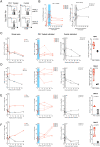PD-1 blockade following ART interruption enhances control of pathogenic SIV in rhesus macaques
- PMID: 35939675
- PMCID: PMC9388156
- DOI: 10.1073/pnas.2202148119
PD-1 blockade following ART interruption enhances control of pathogenic SIV in rhesus macaques
Abstract
Programmed death-1 (PD-1) blockade during chronic Simian immunodeficiency virus (SIV) infection results in restoration of CD8 T-cell function and enhances viral control. Here, we tested the therapeutic benefits of PD-1 blockade administered soon after anti-retrovial therapy (ART) interruption (ATI) by treating SIV-infected and ART-suppressed macaques with either an anti-PD-1 antibody (n = 7) or saline (n = 4) at 4 wk after ATI. Following ATI, the plasma viremia increased rapidly in all animals, and the frequency of SIV-specific CD8 T cells also increased in some animals. PD-1 blockade post ATI resulted in higher proliferation of total memory CD8 and CD4 T cells and natural killer cells. PD-1 blockade also resulted in higher proliferation of SIV-specific CD8 T cells and promoted their differentiation toward better functional quality. Importantly, four out of the seven anti-PD-1 antibody-treated animals showed a rapid decline in plasma viremia by 100- to 2300-fold and this was observed only in animals that showed measurable SIV-specific CD8 T cells post PD-1 blockade. These results demonstrate that PD-1 blockade following ATI can significantly improve the function of anti-viral CD8 T cells and enhance viral control and strongly suggests its potential synergy with other immunotherapies that induce functional CD8 T-cell response under ART. These results have important implications for HIV cure research.
Keywords: HIV; HIV cure; PD-1; SIV.
Conflict of interest statement
Competing interest statement: V.V., K.T., G.J.F., R.A., and R.R.A. are co-inventors of PD-1 technology that has been licensed to Genentech by Emory University. GJF has patents/pending royalties on the PD-1/PD-L1 pathway from Roche, Merck MSD, Bristol-Myers-Squibb, Merck KGA, Boehringer-Ingelheim, AstraZeneca, Dako, Leica, Mayo Clinic, and Novartis. GJF has served on advisory boards for Roche, Bristol-Myers-Squibb, Xios, Origimed, Triursus, iTeos, NextPoint, IgM, Jubilant and GV20. GJF has equity in Nextpoint, Triursus, Xios, iTeos, IgM, and GV20.
Figures




Similar articles
-
Immune checkpoint inhibitors in infectious disease.Immunol Rev. 2024 Nov;328(1):350-371. doi: 10.1111/imr.13388. Epub 2024 Sep 9. Immunol Rev. 2024. PMID: 39248154 Free PMC article. Review.
-
Exacerbated AIDS Progression by PD-1 Blockade during Therapeutic Vaccination in Chronically Simian Immunodeficiency Virus-Infected Rhesus Macaques after Interruption of Antiretroviral Therapy.J Virol. 2022 Feb 9;96(3):e0178521. doi: 10.1128/JVI.01785-21. Epub 2021 Nov 24. J Virol. 2022. PMID: 34818070 Free PMC article.
-
CTLA-4 and PD-1 dual blockade induces SIV reactivation without control of rebound after antiretroviral therapy interruption.Nat Med. 2020 Apr;26(4):519-528. doi: 10.1038/s41591-020-0782-y. Epub 2020 Mar 16. Nat Med. 2020. PMID: 32284611 Free PMC article.
-
Combination anti-PD-1 and antiretroviral therapy provides therapeutic benefit against SIV.JCI Insight. 2018 Sep 20;3(18):e122940. doi: 10.1172/jci.insight.122940. eCollection 2018 Sep 20. JCI Insight. 2018. PMID: 30232277 Free PMC article.
-
Mechanisms of CD8+ T cell-mediated suppression of HIV/SIV replication.Eur J Immunol. 2018 Jun;48(6):898-914. doi: 10.1002/eji.201747172. Epub 2018 Mar 26. Eur J Immunol. 2018. PMID: 29427516 Free PMC article. Review.
Cited by
-
Immune checkpoint inhibitors in infectious disease.Immunol Rev. 2024 Nov;328(1):350-371. doi: 10.1111/imr.13388. Epub 2024 Sep 9. Immunol Rev. 2024. PMID: 39248154 Free PMC article. Review.
-
TGF-β mediates epigenetic control of innate antiviral responses and SIV reservoir size.Res Sq [Preprint]. 2025 Mar 19:rs.3.rs-5626892. doi: 10.21203/rs.3.rs-5626892/v1. Res Sq. 2025. PMID: 40166014 Free PMC article. Preprint.
-
From natural defenders to therapeutic warriors: NK cells in HIV immunotherapy.Immunotherapy. 2025 Feb;17(2):133-145. doi: 10.1080/1750743X.2025.2460965. Epub 2025 Feb 5. Immunotherapy. 2025. PMID: 39905963 Review.
-
Understanding the HIV-specific T-cell response to immune checkpoint blockade: what can we learn from cancer immunotherapy?Curr Opin HIV AIDS. 2025 Sep 1;20(5):441-448. doi: 10.1097/COH.0000000000000957. Epub 2025 Jul 18. Curr Opin HIV AIDS. 2025. PMID: 40682400 Free PMC article. Review.
-
Immune checkpoint inhibitors as potential therapy for reverting T-cell exhaustion and reverting HIV latency in people living with HIV.Front Immunol. 2023 Dec 7;14:1270881. doi: 10.3389/fimmu.2023.1270881. eCollection 2023. Front Immunol. 2023. PMID: 38130714 Free PMC article. Review.
References
-
- Day C. L., et al. , PD-1 expression on HIV-specific T cells is associated with T-cell exhaustion and disease progression. Nature 443, 350–354 (2006). - PubMed
-
- Trautmann L., et al. , Upregulation of PD-1 expression on HIV-specific CD8+ T cells leads to reversible immune dysfunction. Nat. Med. 12, 1198–1202 (2006). - PubMed
-
- Barber D. L., et al. , Restoring function in exhausted CD8 T cells during chronic viral infection. Nature 439, 682–687 (2006). - PubMed
Publication types
MeSH terms
Substances
Grants and funding
LinkOut - more resources
Full Text Sources
Research Materials

